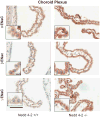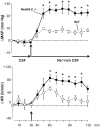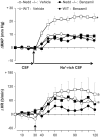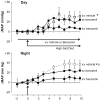Salt-induced hypertension in a mouse model of Liddle syndrome is mediated by epithelial sodium channels in the brain
- PMID: 22802227
- PMCID: PMC3514876
- DOI: 10.1161/HYPERTENSIONAHA.112.193045
Salt-induced hypertension in a mouse model of Liddle syndrome is mediated by epithelial sodium channels in the brain
Abstract
Neural precursor cell expressed and developmentally downregulated 4-2 protein (Nedd4-2) facilitates the endocytosis of epithelial Na channels (ENaCs). Both mice and humans with a loss of regulation of ENaC by Nedd4-2 have salt-induced hypertension. ENaC is also expressed in the brain, where it is critical for hypertension on a high-salt diet in salt-sensitive rats. In the present studies we assessed whether Nedd4-2 knockout (-/-) mice have the following: (1) increased brain ENaC; (2) elevated cerebrospinal fluid (CSF) sodium on a high-salt diet; and (3) enhanced pressor responses to CSF sodium and hypertension on a high-salt diet, both mediated by brain ENaC. Prominent choroid plexus and neuronal ENaC staining was present in -/- but not in wild-type mice. In chronically instrumented mice, ICV infusion of Na-rich artificial CSF increased mean arterial pressure 3-fold higher in -/- than in wild-type mice. ICV infusion of the ENaC blocker benzamil abolished this enhancement. In telemetered -/- mice on a high-salt diet (8% NaCl), CSF [Na(+)], mean arterial pressure, and heart rate increased significantly, mean arterial pressure by 30 to 35 mmHg. These mean arterial pressure and heart rate responses were largely prevented by ICV benzamil but only to a minor extent by SC benzamil at the ICV rate. We conclude that increased ENaC expression in the brain of Nedd4-2 -/- mice mediates their hypertensive response to a high-salt diet by causing increased sodium levels in the CSF, as well as hyperresponsiveness to CSF sodium. These findings highlight the possible causative contribution of central nervous system ENaC in the etiology of salt-induced hypertension.
Conflict of interest statement
Figures





Similar articles
-
Renal tubular NEDD4-2 deficiency causes NCC-mediated salt-dependent hypertension.J Clin Invest. 2013 Feb;123(2):657-65. doi: 10.1172/JCI61110. Epub 2013 Jan 25. J Clin Invest. 2013. PMID: 23348737 Free PMC article.
-
Salt-sensitive hypertension and cardiac hypertrophy in mice deficient in the ubiquitin ligase Nedd4-2.Am J Physiol Renal Physiol. 2008 Aug;295(2):F462-70. doi: 10.1152/ajprenal.90300.2008. Epub 2008 Jun 4. Am J Physiol Renal Physiol. 2008. PMID: 18524855 Free PMC article.
-
Hrs controls sorting of the epithelial Na+ channel between endosomal degradation and recycling pathways.J Biol Chem. 2010 Oct 1;285(40):30523-30. doi: 10.1074/jbc.M110.150755. Epub 2010 Jul 30. J Biol Chem. 2010. PMID: 20675381 Free PMC article.
-
NEDD4-2 and salt-sensitive hypertension.Curr Opin Nephrol Hypertens. 2015 Mar;24(2):111-6. doi: 10.1097/MNH.0000000000000097. Curr Opin Nephrol Hypertens. 2015. PMID: 25602517 Review.
-
ENaC and its regulatory proteins as drug targets for blood pressure control.Curr Drug Targets. 2008 Aug;9(8):709-16. doi: 10.2174/138945008785132367. Curr Drug Targets. 2008. PMID: 18691017 Review.
Cited by
-
Pivotal role of α2 Na+ pumps and their high affinity ouabain binding site in cardiovascular health and disease.J Physiol. 2016 Nov 1;594(21):6079-6103. doi: 10.1113/JP272419. Epub 2016 Jul 31. J Physiol. 2016. PMID: 27350568 Free PMC article. Review.
-
The role of CNS in salt-sensitive hypertension.Curr Hypertens Rep. 2013 Aug;15(4):390-4. doi: 10.1007/s11906-013-0358-z. Curr Hypertens Rep. 2013. PMID: 23689978 Review.
-
Regulation of CSF and Brain Tissue Sodium Levels by the Blood-CSF and Blood-Brain Barriers During Migraine.Front Comput Neurosci. 2020 Feb 4;14:4. doi: 10.3389/fncom.2020.00004. eCollection 2020. Front Comput Neurosci. 2020. PMID: 32116618 Free PMC article.
-
UBR1 Promotes Sex-Dependent ACE2 Ubiquitination in Hypertension.Hypertension. 2025 Jan;82(1):84-95. doi: 10.1161/HYPERTENSIONAHA.124.23196. Epub 2024 Nov 27. Hypertension. 2025. PMID: 39601126
-
How NaCl raises blood pressure: a new paradigm for the pathogenesis of salt-dependent hypertension.Am J Physiol Heart Circ Physiol. 2012 Mar 1;302(5):H1031-49. doi: 10.1152/ajpheart.00899.2011. Epub 2011 Nov 4. Am J Physiol Heart Circ Physiol. 2012. PMID: 22058154 Free PMC article. Review.
References
-
- Hansson JH, Schild L, Lu Y, Wilson TA, Gautschi I, Shimkets R, Nelson-Williams C, Rossier BC, Lifton RP. A de novo missense mutation of the beta subunit of the epithelial sodium channel causes hypertension and Liddle syndrome, identifying a proline-rich segment critical for regulation of channel activity. Proc Natl Acad Sci USA. 1995;92:11495–1149. - PMC - PubMed
-
- Amin MS, Wang HW, Reza E, Whitman S, Tuana B, Leenen FHH. Distribution of epithelial sodium channels and mineralocorticoid receptors in cardiovascular regulatory centers of the rat brain. Am J Physiol. 2005;289:R1787–R1797. - PubMed
Publication types
MeSH terms
Substances
Grants and funding
LinkOut - more resources
Full Text Sources
Medical
Molecular Biology Databases

